Comprehensive Psychology of Self and Personality: Theories, Traits, and Biological Influences
1/112
There's no tags or description
Looks like no tags are added yet.
Name | Mastery | Learn | Test | Matching | Spaced |
|---|
No study sessions yet.
113 Terms
Self-Concept
What you know and believe about yourself.
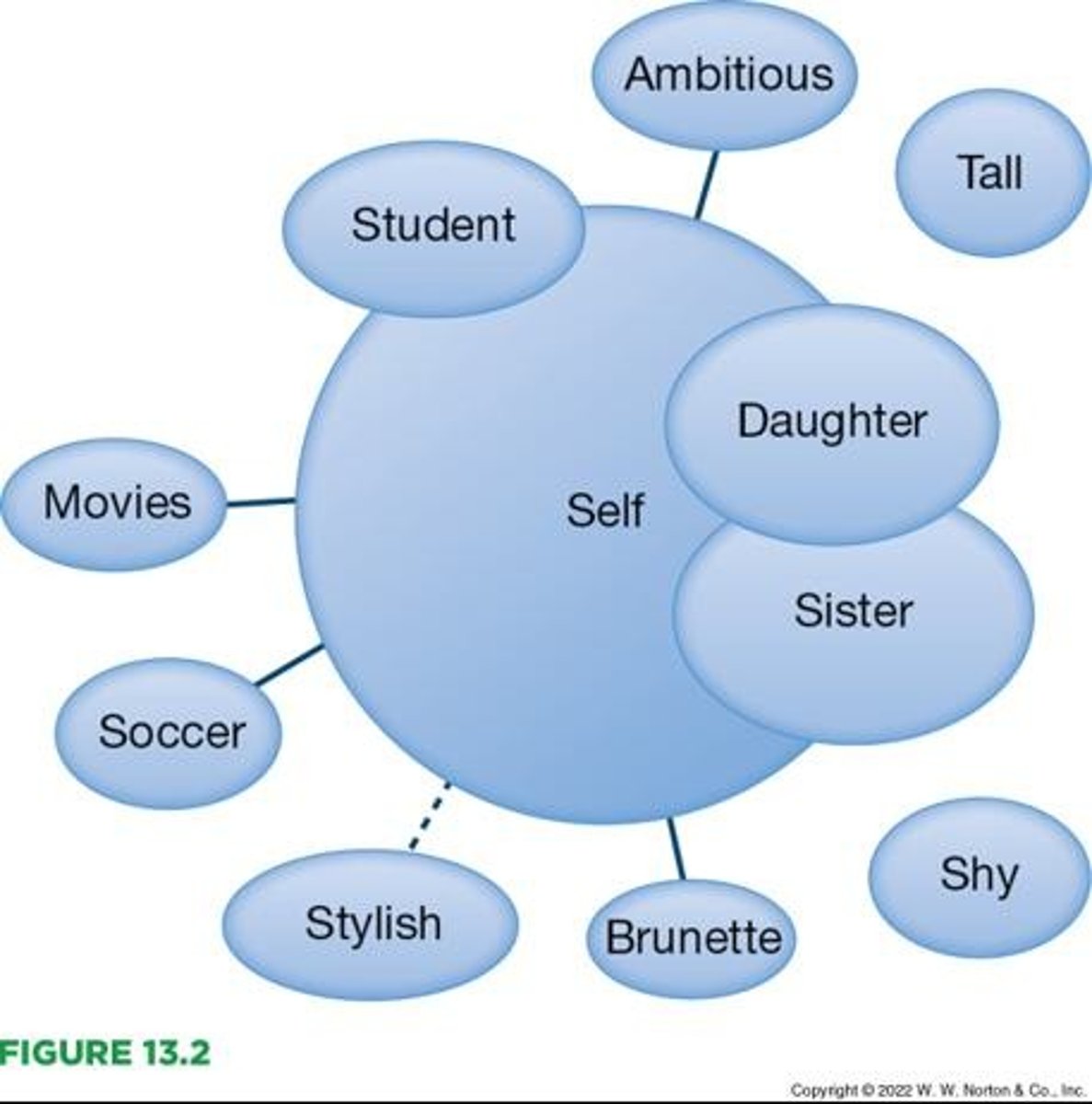
Value of Self
People differ in how they value themselves.
Positive Sense of Self
You try to create a positive sense of self.
Cultural Factors
Your sense of self is influenced by cultural factors.
Psychodynamic Theory
Emphasizes unconscious conflicts.
Humanistic Approaches
Emphasize goodness in people.
Social Cognitive Approaches
Focus on how thoughts shape personality.
Trait Approaches
Describe characteristics.
Biological Basis of Personality
Personality has a biological basis.
Influence of Genes
Personality is influenced by genes.
Innate Temperament
Temperament is innate.
Personality Stability
Influenced by biology and situation.
Methods to Assess Personality
Several methods are used to assess personality.
Behavior Influence
Behavior is influenced by personality and situation.
Personality
A person's typical thoughts, emotional responses, and behaviors that are relatively stable over time and across circumstances.
Self-schema
An integrated set of memories, beliefs, and generalizations about the self.
Working self-concept
The immediate experience of the self in the here and now.
Self-esteem
How you feel about your sense of self; many theories propose that self-esteem is based on how we believe others perceive us.
Reflected appraisal
The view that self-esteem is based on how we believe others perceive us.
Self-compassion
Refers to treating oneself with care, acceptance, and kindness during difficult times; it was found to be a good predictor of better mental health during the first year of college.
Self-esteem and life outcomes
Evidence from psychology indicates that self-esteem may be less important than is commonly believed.
Narcissism
A personality trait characterized by inflated self-esteem; an analysis found increasing narcissism among American college students between 1979 and 2006.
Adolescence and self-esteem
There is a tendency for self-esteem to fall during adolescence and be at its lowest for people, especially young women, aged 18 to 22 years.
Interpersonal style
Refers to characteristics such as being shy or friendly that contribute to an individual's sense of self.
Personal characteristics
Traits such as being moody or optimistic that are part of an individual's self-concept.
Body image
An individual's perception of their physical appearance, which can be positive or negative.
Age
A factor that typically influences a college student's sense of self.
Student status
A factor that typically influences a college student's sense of self.
Research on self-processing
Researchers typically observe activity in the middle of the frontal lobes of the brain when people process information about themselves.
Features of self-concept
Research respondents are especially likely to mention features such as ethnicity, gender, or age if they differ in these respects from others around them.
Happiness and self-esteem
Although people with high self-esteem report being much happier than others, self-esteem is weakly related to objective life outcomes.
Mental health predictor
Self-compassion was found to be a good predictor of better mental health during the first year of college.
Dark triad
Describe three negative personality traits including narcissism, psychopathy, and Machiavellianism.
Psychopathy
Revolves around a general lack of caring for the welfare of others.
Machiavellianism
Describes traits of those who manipulate others for their own gain and who lack conventional morality.
Better-than-average effect
Statistically, it is impossible for everyone to be above average. People with high self-esteem are especially likely to exhibit this effect.
Positive illusions
Most people have positive illusions—that is, overly favorable and unrealistic beliefs—in at least three areas.
Downward comparisons
Comparing oneself with another person who is seen as less competent or in a worse situation, which tends to protect a person's high self-esteem.
Temporal comparison
In which people view their current selves as better than their former selves.
Upward comparisons
Comparing oneself with another person who is seen as more competent or in a better situation, which tends to confirm a person's low self-esteem.
Self-serving bias
The tendency for people to take personal credit for success but blame failure on external factors.
Collectivist cultures
Emphasize connections to family, social groups, and ethnic groups, and conformity to societal norms.
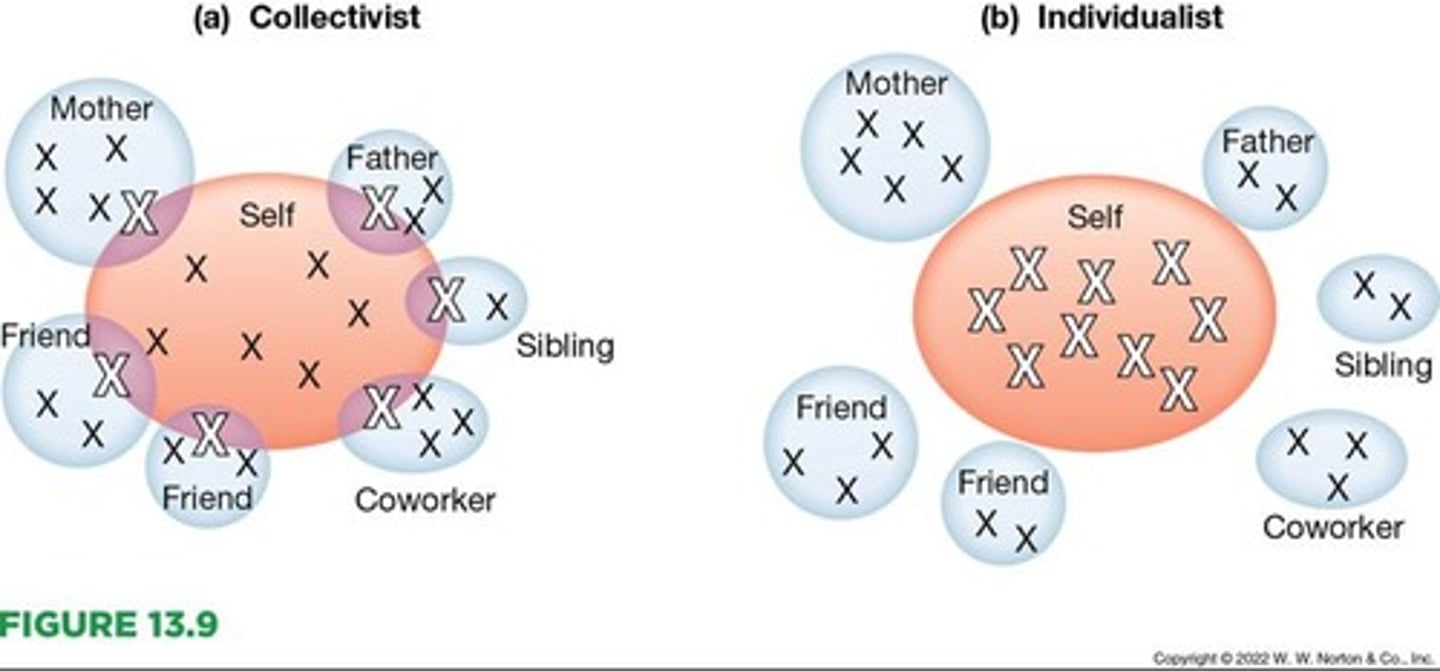
Individualist cultures
Emphasize rights and freedoms, self-expression, and diversity.
Freud's conscious level
Consists of the thoughts that we are aware of.
Freud's preconscious level
Consists of content that is not currently in our awareness but that could be brought to awareness.
Freud's unconscious level
Contains material that the mind cannot easily retrieve.
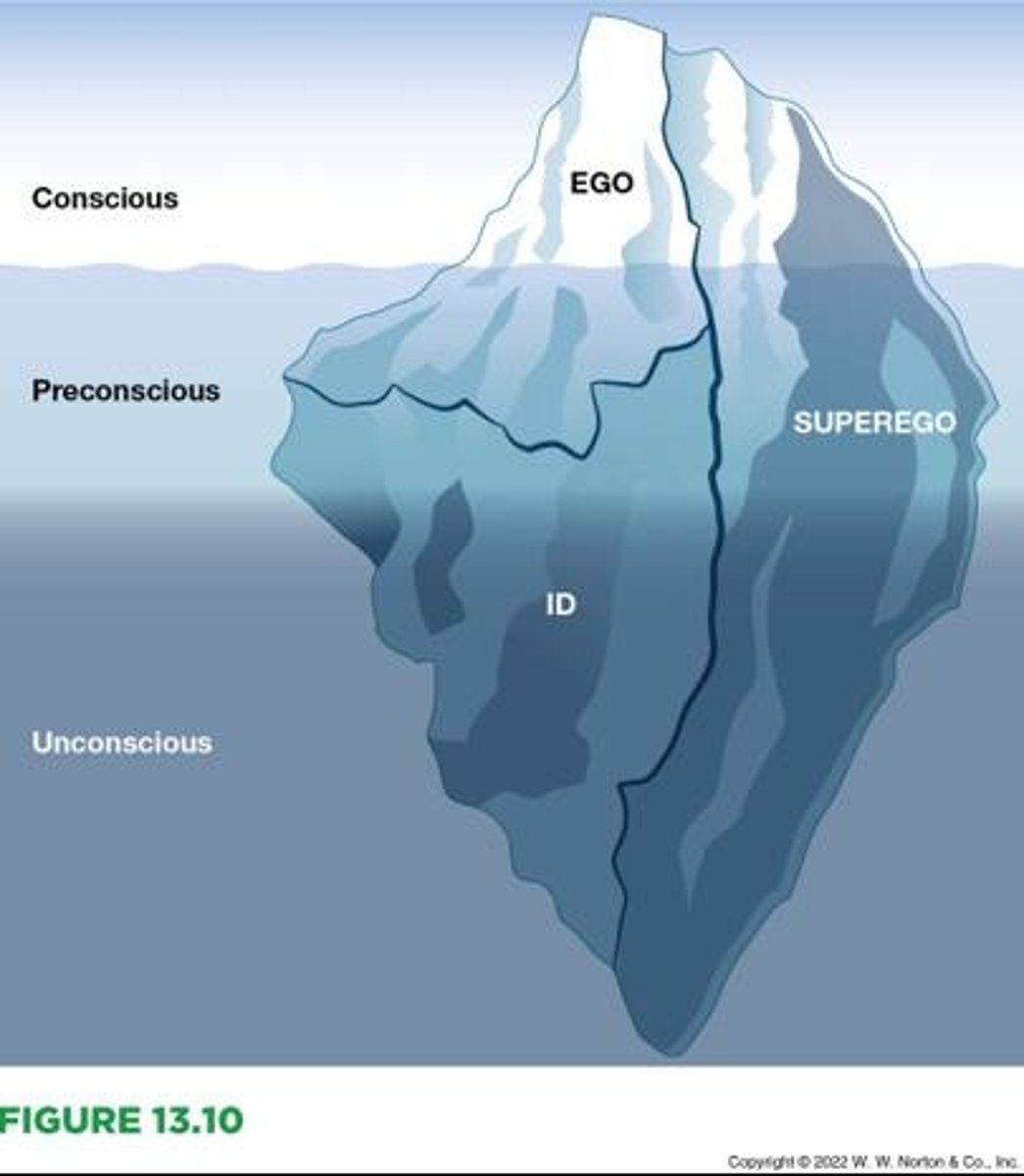
Id
In psychodynamic theory, the component of personality that is completely submerged in the unconscious and operates according to the pleasure principle.
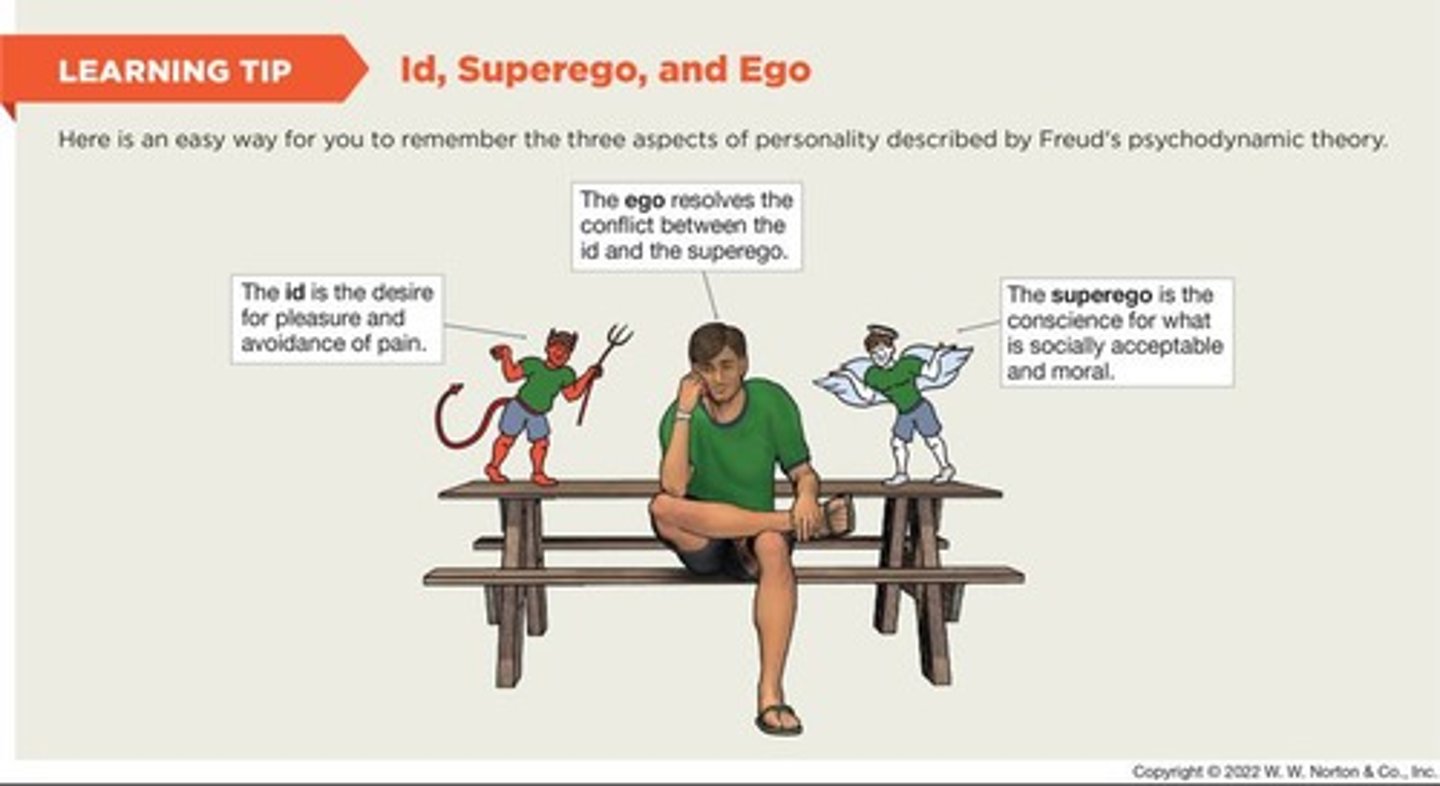
Libido
Freud called the force that drives the pleasure principle.
Superego
In psychodynamic theory, the component of personality that reflects the internalization of societal and parental standards of conduct.
Ego
In psychodynamic theory, the component of personality that tries to satisfy the wishes of the id while being responsive to the superego.
Reality principle
The principle according to which the ego operates, involving rational thought and problem solving.
Defense mechanisms
In psychodynamic theory, unconscious mental strategies that the mind uses to protect itself from distress.
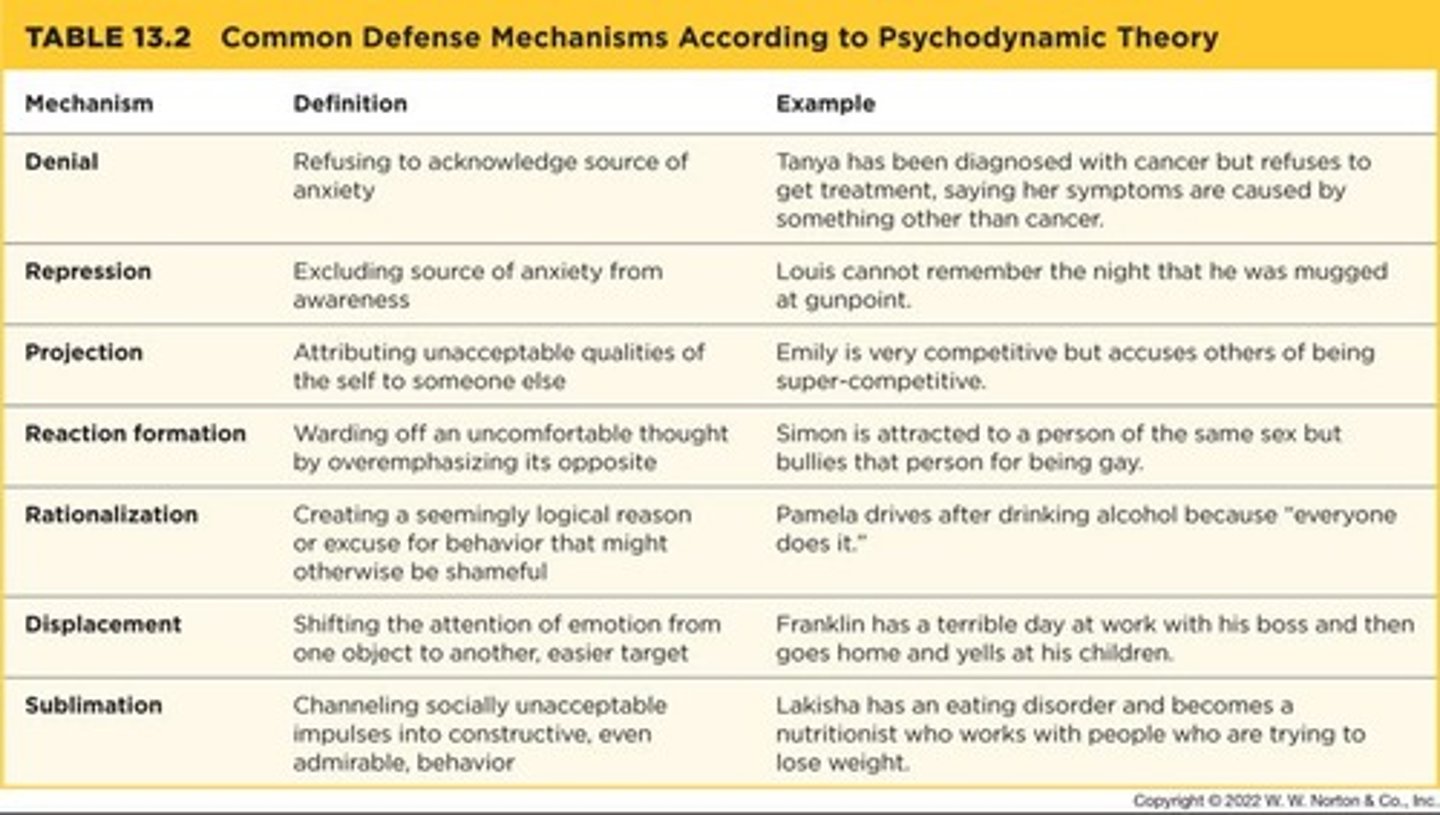
Object relations theory
A theory suggesting that our mind and sense of self develop in relation to others ('objects') in our environment, shaping our personality.
Person-centered approach
Carl Rogers's approach to understanding personality and human relationships, emphasizing the importance of people's treatment by others.
Conditions of worth
The evaluations of others that shape personality.
Unconditional positive regard
An important concept in Rogers's theory, referring to accepting and valuing a person without conditions.
Expectancy theory
A theory explaining how personality is learned, recognizing the influence of how people think.
Anxiety
A feeling that arises from conflicts between the id and the superego.
Neo-Freudians
Contemporary psychologists who focus on social interactions and have largely abandoned traditional psychodynamic theories.
Self-actualization
The process of realizing one's potential and seeking personal growth.
Rationalization
A defense mechanism where a person justifies their behavior by blaming the situation.
Internalization
The process of integrating societal and parental standards into one's own values.
Self-understanding
The awareness of one's own personality, including thoughts, feelings, and motivations.
Influence of others
The impact that interpersonal relationships have on personality development.
Locus of Control
Locus of control refers to people's perception of whether they control the rewards and punishments they experience (internal locus of control) or not (external locus of control).

Reciprocal Determinism
Reciprocal determinism explains personality based on three factors: a person's environment, person factors (including characteristics, self-confidence, and expectations), and behavior itself.
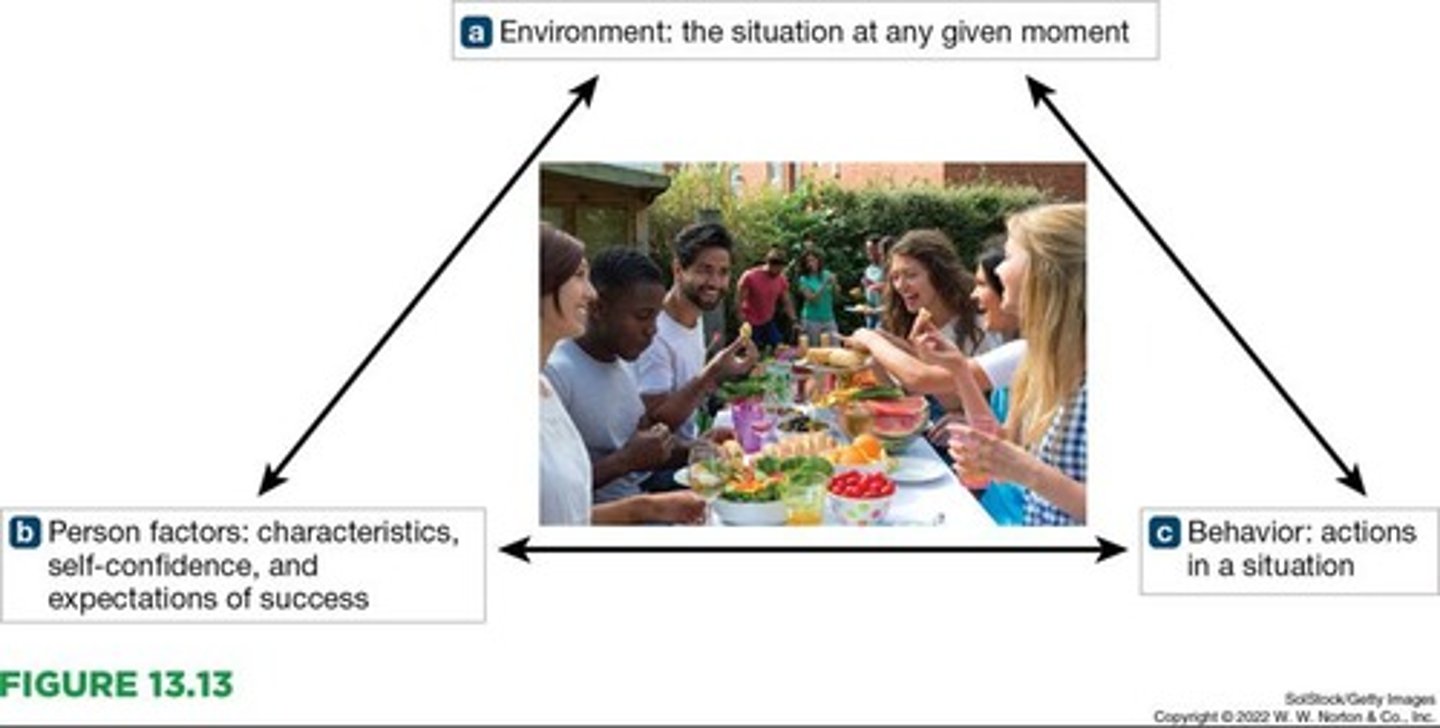
Continuum of Traits
Traits exist on a continuum, with most people falling somewhere in the middle and relatively few at the extremes.
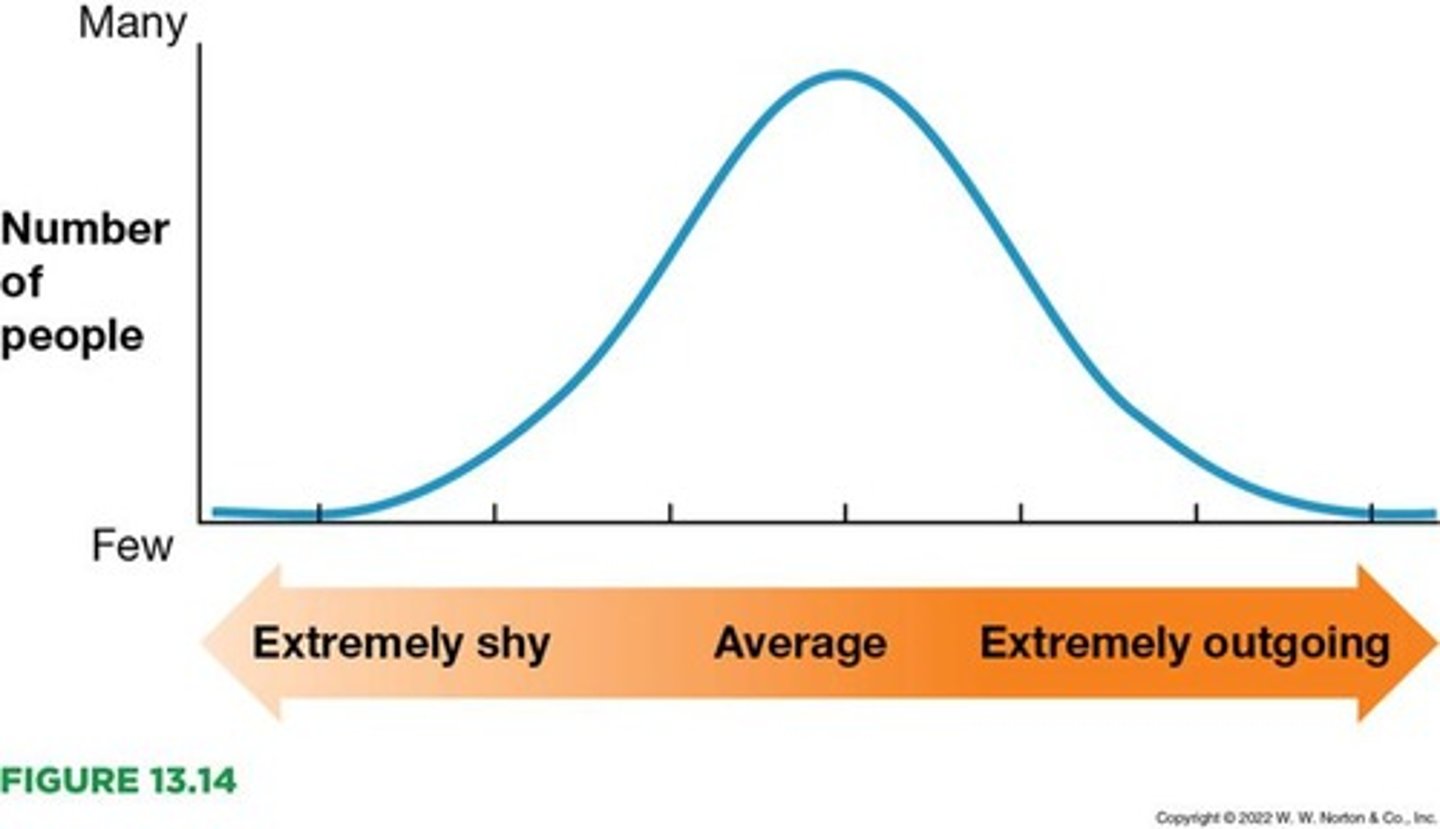
Eysenck's Trait Theory
Eysenck developed the biological trait theory, proposing that personality traits had two major dimensions: how outgoing people were and whether their emotions tended to be stable or unstable.
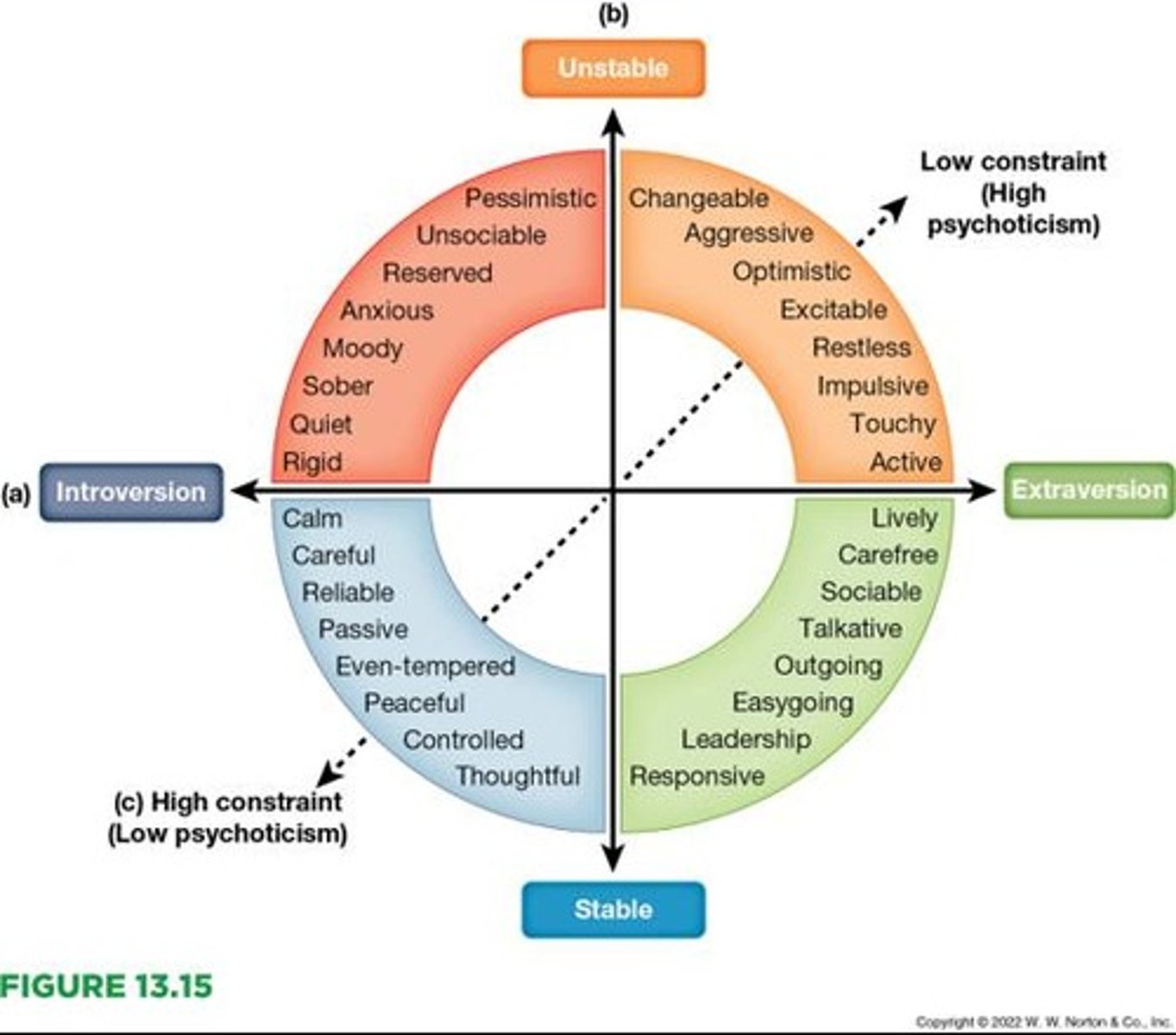
Introversion
Introversion refers to how shy, reserved, and quiet a person is.
Extraversion
Extraversion refers to how sociable, outgoing, and bold a person is.
Psychoticism
Psychoticism reflects a mix of aggression, poor impulse control, self-centeredness, and/or a lack of empathy, and is now called constraint.
Five-Factor Trait Theory
The five-factor trait theory identifies five basic personality traits, with considerable evidence supporting its validity across cultures and among adults and children.

Personality Similarity
Carli and colleagues (1991) found that personality similarity between roommates was positively correlated with both relationship satisfaction and intent to live together the following year.
Roommate Conflict
Ogletree and colleagues (2005) found that a third of the college-age people in their study reported experiencing roommate conflict related to the cleanliness of their living space.
Biology and Personality
How Does Biology Affect Personality?
Personality Has a Biological Basis
Research on the neurobiological underpinnings of personality has explored the dimension of extraversion and introversion.
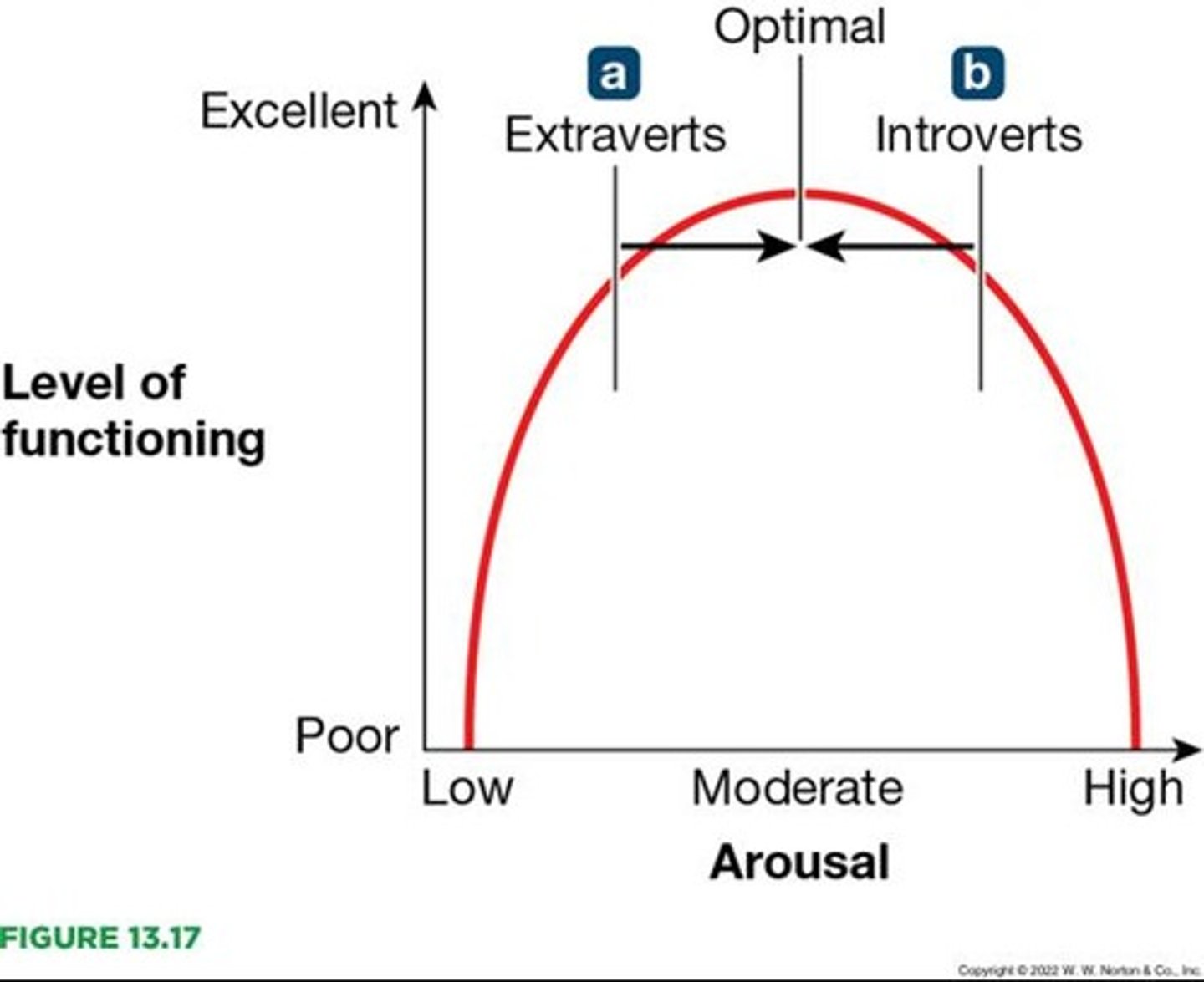
Reticular activating system (RAS)
A system involved in the regulation of arousal and consciousness, linked to personality traits.
Personality Is Influenced by Genes
Research has shown that certain genes can be linked with some personality traits.
Identical twins
Numerous studies have shown that identical twins are more similar than non-identical twins in personality traits described by the five-factor theory.
Adoption studies
Further evidence for the genetic basis of personality comes from adoption studies.
Temperament
Biologically based tendency to feel or act in certain ways.
Innate biological structures of personality
Life experiences may alter personality traits, but temperaments represent the innate biological structures of personality.
Three aspects of temperament
Three personality characteristics can be considered temperaments: Activity level, Emotionality, Sociability.
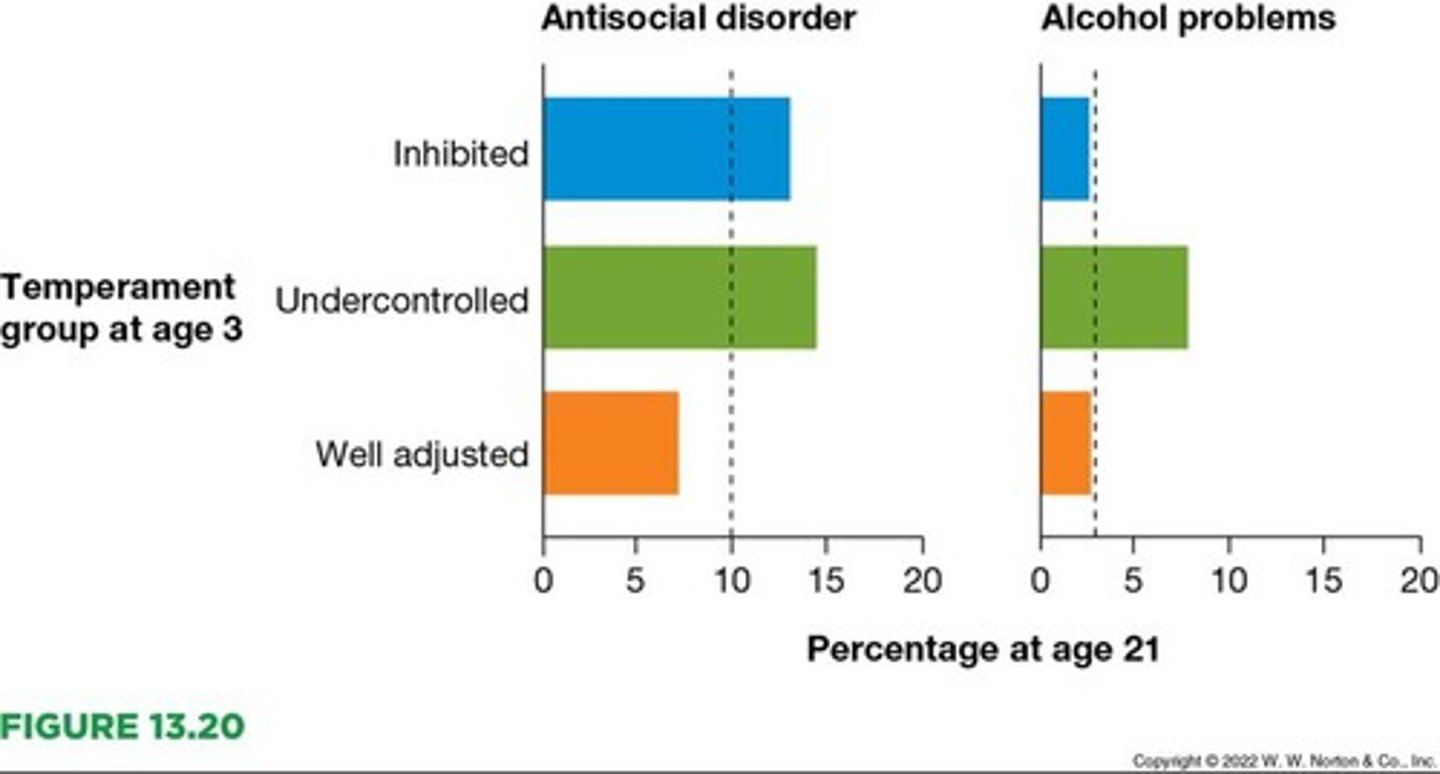
Long-term effects of temperament
Early childhood temperament appears to influence behavior and personality significantly throughout a person's development.
Personality Stability Is Influenced by Biology and Situation
Genetic makeup may predispose people to have certain personality traits or characteristics.
Fixed or changeable personality
Whether personality is fixed or changeable depends largely on how we define the essential features of personality.
Stability of personality traits
Personality traits are generally stable over time.

Cross-cultural findings
Suggest that age-related changes in personality occur independently of environmental influences.
Basic tendencies
Personality traits that are largely determined by biology and are stable over time.
Characteristic adaptations
Changes in behavioral expression of basic tendencies based on the demands of specific situations.

Situational causes of personality change
Life's circumstances generally produce changes in personality, especially during emerging adulthood.
Job satisfaction and neuroticism
Greater job satisfaction can decrease neuroticism over time.
Age-related roles and personality change
Personality changes occur as a result of the expectations and experiences associated with age-related roles.
Committed relationship and neuroticism
Becoming involved in a committed relationship is associated with decreased neuroticism.
How can understanding people's personalities become a career?
A question regarding the application of personality understanding in professional contexts.
How Can Personality Be Assessed?
A question regarding the methods and tools used to evaluate personality.
Projective measures
Personality tests that examine unconscious processes by having people interpret ambiguous stimuli.
Rorschach inkblot test
A projective test that uses inkblots to assess personality and emotional functioning.
Thematic Apperception Test (TAT)
A projective test that involves storytelling about ambiguous images to reveal underlying motives and concerns.
Self-report measures
Personality tests that use questionnaires to let people respond to items that reveal traits and behaviors.